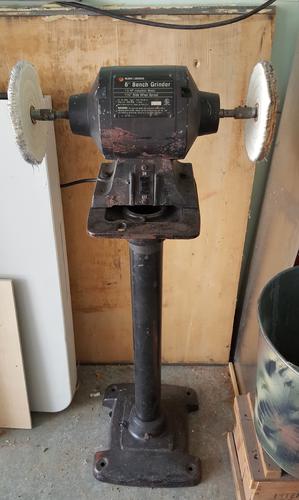Results 11 to 19 of 19
Thread: First Buffer
-
04-10-2016, 02:07 AM #11illegitimum non carborundum



- Join Date
- Jan 2008
- Location
- Rochester, MN
- Posts
- 11,552
- Blog Entries
- 1
Thanked: 3795
RPMs don't matter. Feet per second does. With a faster buffer you use smaller wheels. A trade off though is that you will have to re-load your wheels more frequently, but that's not that big of a deal.
-
The Following User Says Thank You to Utopian For This Useful Post:
MisterClean (04-10-2016)
-
04-10-2016, 02:30 AM #12

This was sent to me by 'Pee Wee Herman' while I was building my buffer.
And it's!
GREAT INFORMATION!
Formula to figure final speeds on belt driven buffers/grinders.
Shaft and Pulley Speed Calculator Links and Formulas
Pulley and RPM Calculator | Engineering Information - Culver Armature and Motor
Pulley, Diameter and Belt Size Calculator
Refrigerative Supply Resources Overview
Determining Pulley Speeds
Pulley Sizing
Take this little formula to figure your speed:
rpm of motor divided by the diameter of the pulley.
Use this as an example.
1750 rpm divided by 6" pulley=291
291rpm divided by 3" pulley = 97 rpm
A 10 inch wheel will run 97 rpm. So will a 6 inch wheel.
The surface speed is a different matter though. You might want to drop down to a smaller wheel:
A 10" wheel at 97 rpm is running 3,048 inches per minute.
A 6" wheel at 97 rpm is running 1,828 inches per minute
Formula to figure surface speeds of wheels:
10" x 3.1416 x 97 = surface inches per minute.
6" x 3.1416 x 97 = surface inches per minute.
Hope this helps!!Our house is as Neil left it- an Aladdins cave of 'stuff'.
Kim X
-
The Following 3 Users Say Thank You to cudarunner For This Useful Post:
Chevhead (04-15-2016), Geezer (04-10-2016), MisterClean (04-10-2016)
-
04-10-2016, 04:32 AM #13illegitimum non carborundum



- Join Date
- Jan 2008
- Location
- Rochester, MN
- Posts
- 11,552
- Blog Entries
- 1
Thanked: 3795
HERE's more for you to read from Caswell. Actually, this is the stuff you should study.
Please make particular note of the SAFE and UNSAFE areas of the wheel. I have posted this before and some have disagreed with those safe zones. I don't care. Study it for yourself and understand it for yourself.
And here is an additional safety note. I think there as a thread several years ago entitled "YOUR BUFFER CAN KILL YOU." I capitalized it since your buffer can kill you, and not for the reason of a flying blade (though that can hurt too) but because of all of the fibers and crap from the wheels and compound can end up in your lungs. If you use a buffer you need to use a respirator. YOU NEED TO USE A RESPIRATOR.
-
The Following 4 Users Say Thank You to Utopian For This Useful Post:
Chevhead (04-15-2016), cudarunner (04-10-2016), Geezer (04-10-2016), MisterClean (04-10-2016)
-
04-10-2016, 06:39 PM #14

It looks like I have studying and research to do, thanks again to all for taking the time to help me. Freddie
-
04-15-2016, 07:20 PM #15


So here's what I ended up with.... a B&D 1/3 HP motor 3500 rpm with stand, wheels and spindles. A friend of my has a pawn shop and I got it for $75.00. It was too good a deal to pass up.
-
04-15-2016, 07:25 PM #16

Should get you down the road Freddie.

However if you look at the formulas that I sent you'll have a lot less heat if you drop down to 4" buffer pads. Plus you can get into the recesses much better. There are many, many places that sell the 4" spiral sewn pads and they aren't expensive.Our house is as Neil left it- an Aladdins cave of 'stuff'.
Kim X
-
04-15-2016, 07:54 PM #17

Cudarunner,
Yep, I read and studied the info, very helpful. Those pads came with the deal so I'll get some 4" wheels soon. The compound sticks that came with the deal are all dried up. I bought Tripoli Brown for cleaning and a White for polishing. Thanks again for all your help.
-
04-15-2016, 11:26 PM #18
-
04-15-2016, 11:28 PM #19


 18Likes
18Likes LinkBack URL
LinkBack URL About LinkBacks
About LinkBacks






 Reply With Quote
Reply With Quote

